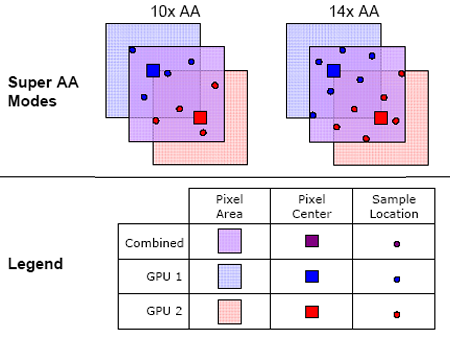ATI's Multi-GPU Solution: CrossFire
by Anand Lal Shimpi & Derek Wilson on May 30, 2005 9:00 PM EST- Posted in
- GPUs
Super AA Modes
There are some older games that wouldn't see any benefit from a multi-GPU solution, as these titles may not be GPU limited. In order to provide some benefit to these games (while at the same time offering higher image quality), ATI has devised four multi-card display modes. These modes are user selectable from the control panel and can help add smoothness and clarity to any title.The compatibility of ATI's Super AA modes is not limited to any subset of titles because there is no workload split involved - each card renders the entire scene, each with a unique set of sample points. Before display, the compositing engine takes the output of each card and prepares a final image for display.

Two of the new modes simply make use of different sample points. 8xAA and 12xAA employ either 4x or 6x AA modes on each card. Of course, MSAA is limited in its ability to antialias certain aspects of a 3D scene. Multisample only works along polygon edges, while the slower supersample method works across the entire scene (including textures). SSAA has fallen out of use due to the rather large performance impact that it has on a single card. The modus operandi for SSAA is to render a scene at a higher resolution and then resample the image to the desired resolution. Of course, there are other ways of performing SSAA.

ATI is able to handle SSAA by rendering the entire scene at the desired resolution on each card with a half pixel diagonal shift. They combine this method with either their 8x or 12x MSAA modes in order to produce 10xAA (4x + 4x + 2xSS) and 14xAA (6x + 6x + 2xSS). These quality modes should prove to be phenomenal.
These 2xSS mode shouldn't be confused with a normal 2x vertical and 2x horizontal resolution mode. In that case, each pixel has 4 ordered sample points that scale down to one pixel. In ATI's mode, 2 sample points are used per pixel in a rotated grid fashion.
These modes add life to games that would not benefit otherwise from multiple graphics cards, as well as provide a compatibility mode to titles for which alternating or splitting frames is not an option. This is a key feature of ATI's CrossFire that separates it from NVIDIA, and we are very eager to get our hands on hardware and test it first hand.
Now that we know what ATI's CrossFire solution is and what it can do, let's take a look at how it stacks up to the competition.










57 Comments
View All Comments
Panndor - Monday, June 13, 2005 - link
Lets hope that this endevor by ATI doesn't end up in the same situation at the RAGE Fury Maxx they came up with. The last time they tried this they screwed it up and then cut support for the card like it never existed.Looks promising, but I could see problems if they allow different hardware to run in a combined mode as well.
Competition is good so maybe this will bring down the price of the boards and the cards now.
vision33r - Wednesday, June 1, 2005 - link
Those 2 X850XT PE cards add up to $1000+ alone while price of 6800U are going down.I think the biggest prob is not if this works or not, is if the mainboard performance is sacrificed due to the ATI north-bridge. I don't gave 90% of the time on my system, I can't sacrifice losing system performance for gaming perf.
xsilver - Wednesday, June 1, 2005 - link
what's funny is that a few months after the xfire is released, nvidia will probably announce SLI v2.0 and then everyone will talk about how that's so coolWesley Fink - Wednesday, June 1, 2005 - link
#49 & #50 - The Uli 1573 we've seen paired with Crossfire DOES suport NCQ. this was confirmed this afternoon with engineers here at Computex. The upcoming ULI 1575 southtridge supports both Sata 2 and NCQ.We also saw demos of Splinter Cell on Crossfire with the 2.0 Shader. The demos were at 1280x1024 with all eye candy enabled. Frame rates in the various demos were 118 to 120. Since we did not have reference benches for Splinter Cell, it didn't make much sense to publish these results in the launch article. What we have seen is very promising, but we need more "hands-on" benchmarking before we can say much more.
Wesley Fink
mkruer - Wednesday, June 1, 2005 - link
#51 That is the real question to be answered. My guess is that ATI will work on a SLI board and visa versa unless there is something specifically in hard coded that prevents the second slot from being used by anything other the chipsets manufactures video card, which is highly unlikely. From the BIOS and driver standpoint the MB is either has 1x16 PCIex slot or 2x8 PCIex slots.elecrzy - Tuesday, May 31, 2005 - link
its possible to have Crossfire work on the NF4/945/955. Its just that ATI won't support them through the drivers. Sigh...kmmatney - Tuesday, May 31, 2005 - link
Does the ULi southbridge have NCQ support?weblizard - Tuesday, May 31, 2005 - link
No Sata II or NCQ support. That's all I need to know to NOT want a crossfire system.bob661 - Tuesday, May 31, 2005 - link
#47I had the Abit board with the AMD chipset on it. Worked flawlessly. I gave it to a friend when I upgraded that box and it was running until last year when he upgraded his box.
sprockkets - Tuesday, May 31, 2005 - link
26# That was the 760MPX or the dual processor chipset. Don't recall any irongate issues (that was 750, 760 was the DDR version, right?)